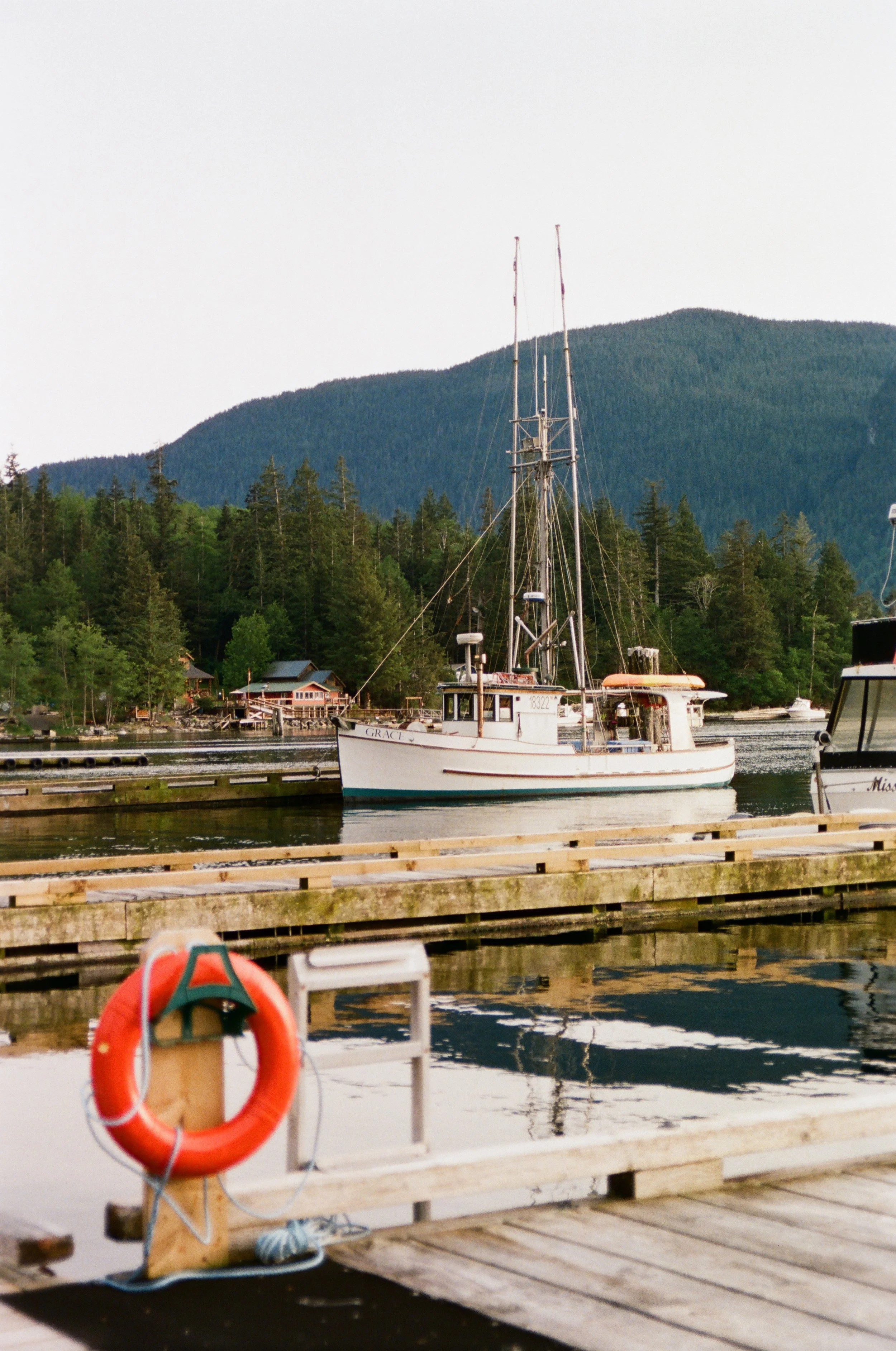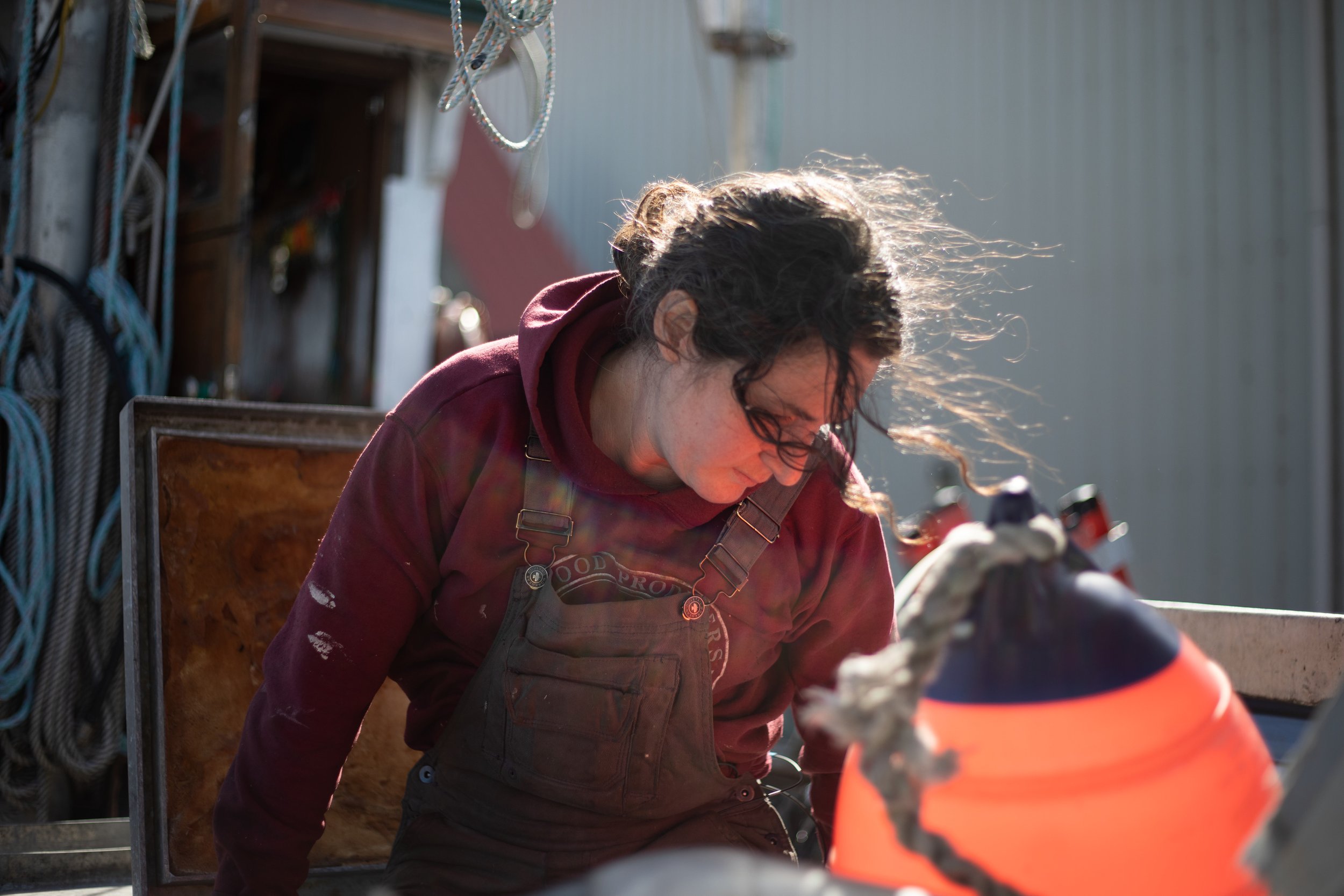the last wild place
FOR SALMON TROLLER KAT MURPHY, WORK IS BOTH RISKY AND MAGICAL
Words by Linda Kramer Jenning
Photos by Natalie Berger
Kat Murphy starts her workday before dawn and doesn’t stop until well after the sun goes down. It’s hard physical labor, often dangerous, and she loves it.
This past summer was Murphy’s sixth season captaining her boat from Port Townsend to Alaska to troll for salmon. She’s one of only a few women making a living this way, spending weeks at a time alone on her 38-foot wooden power troller, the F/V Grace, hunting for the salmon the rest of us love to eat.
Murphy, 37, uses a hook and line to bring in her fish, not a net. She pulls in the salmon one at a time. It’s a way of fishing Murphy and other trollers say makes a difference in both the quality of the fish caught and the environmental impact.
“I feel like I am part of a solution in food production, rather than contributing to a problem,” Murphy says. “I enjoy a job where I fish in a sustainable way. We take such care. We’re trying to maintain this resource for future generations.”
“A trolled salmon is caught and handled individually,” says George Mueller, executive director of the Washington Trollers Association. “Ours is not about quantity, ours is about quality.”
Mueller, who retired after decades on his own boat, says there are currently 152 active commercial salmon troll permits in Washington, and about five are held by women. He says there are husbands and wives who fish together, but many trollers fish alone and work close to nonstop during the season. “It’s a long day, every day. The season is short and you have to make the most of each day.”
While many trollers come from families who’ve been fishing for generations, Murphy took a more circuitous route. She grew up on the East Coast and studied marine science and oceanography before coming to Port Townsend in 2014 to attend the Northwest School of Wooden Boatbuilding. She spent several years at the shipyard, building boats, launching them and then watching as others headed out to sea while she stayed in the dusty yard. Working on land, she decided, was not fulfilling her needs.
“The water always ends up calling to me,” she says. She listened to that call and found a job as a green deckhand with a troller for a season. “It was the steepest learning curve of my life,” she says. She stuck with it, saved her money, bought a boat and in 2018, became captain of her own ship. Murphy has faced challenges, but mentors help her “feel very supported in this community.”


Sarah Franey, 42, of Westport, WA, is another female troller. “I don’t think it made it harder,” she says of being a woman. “I’m not as strong as some guys, but I work really hard. Not everybody wants to work as hard as you have to to be a commercial fisherman.”
Franey, a mother of six, fishes on the Washington, Oregon and California coasts aboard a 45-foot fiberglass Edge Runner with her husband. “You live by the tides and weather and salmon runs and are dependent on everything working out just right. It’s a struggle, but when it works out, it’s worth it. You have to want to do it. I love being a part of the natural world. It feels like magic to me.”
It’s also grueling work. Murphy starts her days before dawn, steering the F/V Grace to find fish, getting her lines ready and, if it’s a good day, hauling in the salmon.
“It’s hard being a troller,” she admits. “I’m always trying to do my best and catch as many fish as possible because I don’t know what’s coming down the pipe. I’m just trying to survive.”
After spending winters maintaining the 77-year-old Grace, she makes her way to the offshore waters of Southeast Alaska, fishing off the coast of Baranof, Kruzof and Coronation islands and using glittering lures to attract wild salmon, mostly king and coho.
“I catch them one at a time,” Murphy says. “They come up live, and I kill every one of them, take the gut and gills out and bleed and ice them. All my fish are layered in the fish hold, and then I lift them out one by one. From the time they hit the deck, they are down below in ice in 30 minutes.”
She delivers her catch to a tender or a town to be processed by canneries. Some fish are blast frozen, some canned and others go to the fresh market. She created her own company, KatFish Salmon, to direct-market her fish to communities around the Olympic Peninsula.
“The tides are everything,” she adds. “Depending on the species of salmon I’m targeting, you just troll slowly all day, hoping the fish will bite and trying not to chase wild herds of salmon around the ocean. Once you’ve found them, you’re trying to get them to bite on your gear. The name of the game in trolling is keeping your gear in the water as long as possible and not stacking it on board and running around everywhere.”
Murphy says the key to trolling is perseverance, and each year she learns to make better decisions. For example, she’s now extra careful around the many sharp objects on her boat. She once nearly cut off a finger and had to turn the boat around to the nearest port with a hospital. Watching the weather is also a learned art, and she has found herself alone at sea amid high winds. Not a mechanic, she learned to fix as much as possible herself.
At times she’s so exhausted, she has to force herself to eat. Other times, she takes a salmon filet, sprinkles on a little olive oil and salt, and pan fries or bakes it. “You want to leave it alone as it is, juicy and delicious and flavorful,” she says of sticking to this basic recipe.
During the season, she occasionally pulls into Petersburg and other towns on Frederick Sound, but mostly she is on the boat by herself, relying on tenders coming to the fishery for a chance to shower, do laundry and pick up supplies. Texting keeps her in touch with friends back home, and she enjoys the community of other trollers radioing back and forth. She also brings along books to keep her company on the slow days, writes poetry and keeps a journal. She has published a chapbook of her work and par- ticipates in the FisherPoets Gathering each February in Astoria, Oregon.
She concedes that trolling alone means twice as much work and nobody to help when things go amiss.
“I was fearful,” she says of the first time she went out by herself. “But it ended up being wonderful. I have the freedom to connect with the natural world in a way that is increasingly rare. It makes me want to cling to it all the more. This is the last wild place.”
What a Chef Says
Does the way a salmon is caught really make a difference in how it tastes? Yes, according to Chef JJ Johnson of Wanderlust NW Catering on Bainbridge Island.“When people talk about the taste difference between well-handled line-caught wild salmon and gill-netted fish, it mainly comes down to texture. A beat-up, mishandled salmon, especially one that has thrashed around slowly dying in a gill net for who knows how long, tends to have a mushier texture to its flesh than an individually line-caught fish, which is reeled in and killed quickly, then put on ice immediately.”
“A chef can tell the difference as soon as we cut into the filet; the flesh can look beat up and is just not palatable anymore. This is also why I’ve never understood the fascination at Pike Place Market with throwing the fish around. Just let them be! It’s not helping the texture to hurl them 30 feet across the counter. Even briefly picking a salmon up by the tail can separate the flesh inside.”
IF YOUR MOUTH IS WATERING FOR SOME KATFISH SALMON HERE’S WHAT TO DO:
Pre-order at katfishsalmonco.com and grab your fresh fish at one of Kat’s November pickup parties at Longship Marine in Poulsbo, Rolling Bay Winery on Bainbridge Island and The Castle in Port Townsend (check website for dates). Canned salmon can be ordered on the website and shipped to any state.Around the region, KatFish Salmon is carried at select farm stores and farmers markets. These may vary year to year, but usually include: Longship Marine in Poulsbo, Chimacum Corner Farmstand, Finnriver Farm & Cidery in Chimacum, Hama Hama Farm Store in Lilliwaup, Port Townsend Food Co-op and Bayview Farm & Gardens in Langley.
In addition, Kat delivers fish shares at wholesale prices to several Jefferson County food banks including those in Port Townsend, Port Hadlock (Tri-Area), Quilcene and Brinnon.

